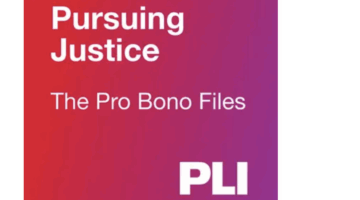 One area of legal technology that has seen an uptick in recent years is trial presentation technology. Both lawyers and judges are more receptive to this idea and for good reason: it streamlines trial presentation and presents information in a format that jurors are more receptive to.
One area of legal technology that has seen an uptick in recent years is trial presentation technology. Both lawyers and judges are more receptive to this idea and for good reason: it streamlines trial presentation and presents information in a format that jurors are more receptive to.
I recently caught up with Mike Ko — founder of Groundwork Trial Consulting and an Adjunct Faculty member at Chicago-Kent College of Law — someone with inside knowledge on how trial technology is being used both inside and outside of the classroom. Mike teaches Litigation Technology and is thus charged with introducing law students to the advantages of using 21st century technologies in the courtroom.
According to Mike, his students are very receptive to learning about trial technology: “It’s one thing to watch a video or read a manual on how to use a piece of software. It’s another thing entirely to have to actually use the software in a real-world type scenario, complete with deadlines and opposing counsel fighting against you. Law students, by their nature, are generally a competitive bunch. Giving them an adversarial forum to learn and perform provides great motivation.”

Pursuing The Pro Bono Story: A Conversation With Alicia Aiken
This Pro Bono Week, get inspired to give back with PLI’s Pursuing Justice: The Pro Bono Files, a one-of-a-kind podcast hosted by Alicia Aiken.
Lawyers have likewise become more amenable to the idea of using technology during trials — and even in pre-trial proceedings — in recent years. “I use these tools on behalf of my clients constantly in trials, hearings, and arbitrations. And very recently, I am seeing demand from some attorneys to be able to incorporate these tools into depositions as well,” he explains. “We use PowerPoint to create compelling presentations that support the substance of our openings. We use Trial Director or TrialPad in order to pull up any page of any exhibit instantly and on demand during cross. These tools play a key roles in video impeachments and we’ve also been able to use PowerPoint to create interactive demonstratives and to create effective timelines that allow lawyers to pull up the relevant document, show the important text, and then go back to the main timeline in a quick and seamless way.”
It’s not just lawyers and law students who are embracing trial technology; as Mike explains, judges are, too. “Judges’ receptiveness to technology has changed dramatically in recent years. When I started using these types of tools in courtrooms almost a decade ago, many judges were confused as to what we were trying to do or why we needed to do it. Today, judges anticipate and generally expect that both sides will be using technology to present their cases, especially in complex cases.”
Why is this technology so beneficial to lawyers? According to Mike, it’s because it simplifies and organizes the trial presentation process and provides information in a way that is easily digestible by jurors. “Using technology in the courtroom gives lawyers an edge over other lawyers who don’t. Today’s jurors are accustomed to receiving and experiencing information on screens and phones, not in print and on poster boards. Being able to present your case in a way that is consistent with how jurors expect to receive it makes it that much easier to win.” He continues, “You’re no longer thumbing through a stack of poster boards to find the right exhibit to put on an easel. Exhibits can be pulled up instantly. And if it’s too small to read, it can be zoomed in on or annotated for emphasis.”
Also, importantly, trial presentation tools help lawyers increase their efficiency and persuasiveness: “Complex concepts or case theories can be distilled into demonstratives, such as graphics or animations, that can quickly convey the essence of a case. Technology lets us quickly arrange and rearrange our view of the case file by what each exhibit is relevant to: issue, standard of care, proximate cause, damages, or witness bias.”

The Trump Gold Card: A New $1 Million Pathway To A U.S. Green Card
A new proposal would let wealthy foreign nationals secure an opportunity for a U.S. green card with a $1 million 'gift' to the government, sparking legal and ethical debate.
Of course it’s not all rainbows and unicorns. Like any type of technology, trial presentation software has drawbacks as well. “It does take time and effort. I think this is something that attorneys who are trying to incorporate technology into their trial practice don’t always anticipate,” he says. “There are learning curves to any type of technology, with the more powerful tools generally taking longer to learn. And even for trial attorneys who would consider their practices to be 100% trial work, they might not get a chance to actually use these tools more than a handful of times per year. Unfortunately, for some people, this just isn’t enough seat-time to be able to use the technology at an optimal level.”
Mike’s advice for lawyers interested in learning more about trial presentation tools? It’s simple. Identify your goals ahead of time. “Figure out what you want to achieve. I get a lot of calls from lawyers along the lines of: ‘I was thinking that I should be using more technology’ or ‘My client wants me to use technology for this trial’ or ‘I just went to a conference where someone said that trial technology is important.’ Successful incorporation of trial technology into your practice requires deliberateness. If you don’t know what you want to achieve, you won’t be able to drive your trial team to get there.”
And, as always, if you or an attorney you know is using technology in a creative or unusual way in your law firm, drop me an email at [email protected]. I’m always looking for new attorneys, law professors, or judges to feature in this column.
 Nicole Black is a Rochester, New York attorney and the Legal Technology Evangelist at MyCase, web-based law practice management software. She’s been blogging since 2005, has written a weekly column for the Daily Record since 2007, is the author of Cloud Computing for Lawyers, co-authors Social Media for Lawyers: the Next Frontier, and co-authors Criminal Law in New York. She’s easily distracted by the potential of bright and shiny tech gadgets, along with good food and wine. You can follow her on Twitter at@nikiblack and she can be reached at [email protected].
Nicole Black is a Rochester, New York attorney and the Legal Technology Evangelist at MyCase, web-based law practice management software. She’s been blogging since 2005, has written a weekly column for the Daily Record since 2007, is the author of Cloud Computing for Lawyers, co-authors Social Media for Lawyers: the Next Frontier, and co-authors Criminal Law in New York. She’s easily distracted by the potential of bright and shiny tech gadgets, along with good food and wine. You can follow her on Twitter at@nikiblack and she can be reached at [email protected].